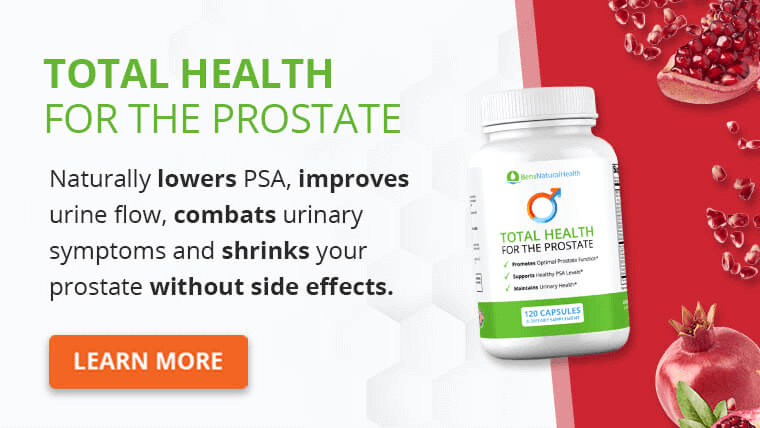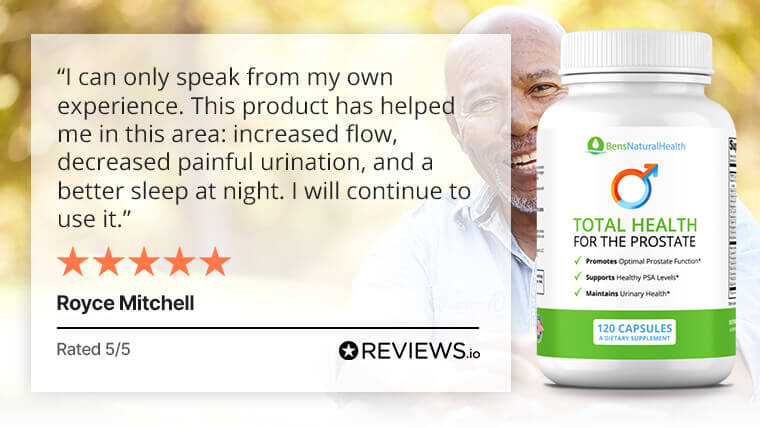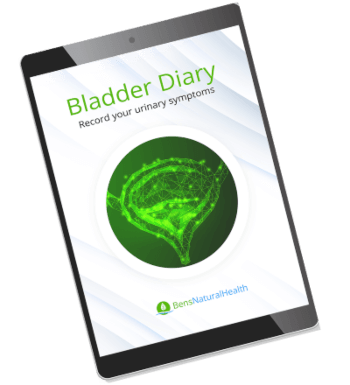Urinary symptoms can be very uncomfortable. Men typically experience worse symptoms as they grow older.
The prostate becomes larger as we age and presses on the urinary tract at some point. Prostate enlargement gives us long-lasting urinary symptoms that affect our quality of life.
Your lifestyle, diet, and the supplements you take can make you feel better.
In this article, we’re walking you through the main recommendations to relieve your urinary symptoms associated with an enlarged prostate.
This is a safe, effective, and all-natural approach to combine with your medical treatment for the best result.

Common urinary symptoms from prostate issues
Urinary symptoms in senior males usually point to prostate enlargement as the likely cause. But how does it feel?
You may encounter all of these symptoms or just a few:
Nocturia
Nocturia is a common symptom when prostate problems are only starting. It increases the urinary frequency at night, waking up the patient with an urge to urinate.
The patient wakes up several times every night and may also develop sleep problems in consequence.
Increased urinary frequency
Even throughout the day, patients with prostate issues may need to urinate more frequently. It becomes an annoying problem when the need to void comes outside of the house.
Thus, in severe cases, these patients may even opt not to leave their homes to avoid awkward moments.
Difficulty to start urinating
This symptom is known as urinary hesitancy. It means that patients are unable to begin urinating without pushing very hard at first.
The process is usually not spontaneous and causes frustration sometimes because these patients previously felt an urgency to urinate, and now it appears they can’t do it.
Sensation of incomplete voiding
After urinating, patients with an enlarged prostate often feel an incomplete emptying of the bladder. Even if they try to push more urine out, they still have a sensation of not eliminating all of the bladder volumes.
Slow urinary flow
This is another common symptom. Patients feel that the urinary stream is changing. It is becoming slow and weak, reducing the volume of urine that is eliminated.
Intermittence and straining
These are two distinct symptoms, both happening at the moment of urinating. Patients need to push very hard to urinate. Otherwise, voiding would stop, and the feeling of incomplete emptying of the bladder would be worse.
They also have an intermittent urine stream. Sometimes it would stop and then resume to stop once again. It is not a continuous stream.
Urinary dribble
All men need to clean after urinating, but those with prostate problems keep dribbling for a long time after voiding. There are two types of urinary dribble: post-void dribble and terminal dribble.
The former happens after you’re apparently done urinating, and it causes stains in your underwear and odors in your clothes. The latter occurs after the main urinary stream. You keep dribbling for some time instead of cutting the stream.
Urge incontinence
In severe cases, patients may also display symptoms of urinary incontinence. There are different types, and they are likely to develop urgency incontinence.
In other words, they suddenly and unexpectedly feel the urge to urinate. The urge cannot be contained, putting them in a very awkward position if they don’t have a bathroom nearby.
Prostate enlargement symptoms vary, and their severity depends on the volume and growth pattern of the prostate. Thus, instead of comparing symptoms with other patients to know if your problem is severe or not, we recommend talking to your doctor if you detect the symptoms listed above.
[be
Get your FREE bladder diary
- Daily bladder diary
- Better understand your urinary symptoms
- Step-by-step guide
How to naturally get rid of your urinary symptoms
Advanced cases of urinary problems may require medical treatment. However, we can also use all-natural measures to get rid of these annoying symptoms. But what can you do on your own to solve the problem?
- Make a few changes in your lifestyle and habits to retrain your bladder
- Stay active and target your pelvic floor muscles
- Detect foods and drinks that help or worsen your symptoms
Studies show that these self-management measures reduce lower urinary tract symptoms in men. They may improve patients’ quality of life as long as they stay in touch and follow the treatment recommended by their doctor.
1) Retrain your bladder
Even patients with very severe symptoms benefit from a bladder retraining program. They are beneficial if you’re experiencing urge urinary incontinence.
You can start by keeping a voiding diary with the symptoms to keep track of your advances. Then, follow these recommendations and evaluate how you feel as you continue doing this:
- Every morning, empty your bladder upon waking.
- If you’re at home during the day, schedule realistic times to visit the bathroom and stick to the schedule as much as possible.
- When you feel the urge to urinate outside of the schedule, try deep breathing and relaxation techniques. If you still can’t suppress the urge, make changes to the program.
- Increase the time between voiding episodes when you reach the goal. Increase 15 minutes every week if everything goes as expected. The goal would be 3-4 hours between urination episodes.
It can take months to reach the goal of 3-4 hours between each urination. During this time, you may have setbacks and bad days depending on what you eat and drink.
That’s why it is important to keep a diary to learn about yourself and your body along the way.
2) Exercise
According to a study in The Journal of Urology, more active patients with prostate problems experience fewer symptoms than sedentary. The risk of moderate and severe urinary symptoms is lower, and they usually have mild symptoms instead.
Even men who are moderately active at work can experience benefits. In contrast, physical inactivity doubles the risk of urinary symptoms later in life.
Thus, the recommendation is to increase your physical activity levels. This will not only reduce your risk of urinary symptoms. It will also improve your cardiovascular health, modulate your mood, and give you extra benefits.
Besides lowering your risk of moderate and severe symptoms, exercise prevents benign prostatic hyperplasia. A recent review evaluated data from 14 studies to investigate the effects of physical activity in the prostate.
According to the available data, patients who exercise more often and continually are less likely to develop BPH. This can be due to a reduction of the sympathetic tone, better control of free radicals, or a lower rate of metabolic syndrome in the exercise group.
As you increase your physical activity, consider focusing your attention on your pelvic floor muscles. There’s a type of exercise known as Kegels, which involves locating your pelvic floor muscles and stimulating them in different settings.
First, locate them by cutting your urine in the middle of the stream. Once you find the muscles involved, contract them at intervals while sitting or lying down.
3) Change your diet
If you keep a voiding diary and make annotations of what you eat and drink, you will see noticeable differences here and there. Certain foods worsen your symptoms, while others are recommended to improve.
For example, eating foods rich in saturated fat is associated with a higher risk of incontinence and post-micturition symptoms. A diet very high in protein levels may increase the risk of nocturia.
Other components in your diet include:
- Fluid intake: It is a fact that more fluid intake increases the urinary output and may increase urinary symptoms. Nocturia improves significantly when patients decrease their fluid intake close to bedtime.
- Caffeine intake: Caffeine is known to irritate the bladder, and it is not recommended in patients with urinary symptoms. It increases urgency incontinence symptoms and increases the urinary volume. Thus, it also precipitates nocturia.
- Alcohol: Similar to caffeine, alcohol increases the urinary output and worsens the urinary symptoms of these patients. However, not all types of alcohol have the same effect. Wines with low alcohol content and higher sugar content may lead to less discomfort in patients with urinary symptoms.
- Carbonated drinks: Various artificial sweeteners used in carbonated beverages stimulate the function of the detrusor muscle in the bladder. Thus, even diet soda is not advised in patients with urinary urgency symptoms.
In contrast, a healthy diet high in fruits and vegetables provides the dietary fiber and nutrients your body needs. It reduces constipation, which usually worsens urinary symptoms, and protects your urinary tract with antioxidants and anti-inflammatory substances.
4) Choose the right supplements
Another step you can take is through supplements and herbal solutions for the prostate. If you want to choose the right supplements for your prostate, keep these in mind:
- Saw palmetto: This is one of the most commonly used extracts for the prostate. It has plenty of scientific evidence and relieves various urinary symptoms. It works in cases of prostate enlargement and may also improve prostatitis symptoms. The effect is similar to finasteride’s, and it doesn’t have any severe side effects.
- Pygeum africanum: This herb has antiandrogenic properties and works against prostate cancer. The flavonoids and other phytochemical substances found in Pygeum africanum reduce prostate tissue proliferation and inhibit growth.
- Vitamin C: This vitamin reduces the urgency people feel to urinate. Men in a 5-year follow-up study also reported improvements in their daytime storage symptoms. In other words, it may reduce urinary frequency. It is better to consume vitamin C with other ingredients to achieve a synergic effect.
- Vitamin D: Low vitamin D levels are associated with a higher risk of urinary symptoms. A deficiency causes pelvic floor dysfunction and worsens urinary symptoms. The protective effect of vitamin D appears to be more pronounced when consumed with potassium and high-quality protein. Thus, vitamin D supplements are recommended for patients with a risk of deficiency.
5) Ben’s Total Health for The Prostate
Our natural prostate supplement, Total Health, contains 21 ingredients specifically designed to improve your urinary flow, reduce nighttime urination and help your sleep better, shrink your prostate, lower your PSA levels, and fight against prostate disease, without any side effects.

Clinical trials and meta-studies show the active ingredients in Total Health have a positive impact on prostate volume, improve lower urinary tract symptoms, and decrease the risk of acute urinary retention.
Why Choose Ben’s Natural Health?
At Ben’s Natural Health, our motto is to combine holistic healing with modern science.
Ben’s Natural Health is the world’s first high-quality, all-natural, scientifically proven clinical supplement company. Above all, prostate health supplements are effective, natural, and 100% side-effect-free.
Moreover, at Ben’s Natural Health, we have four rules for all our supplements:
- We only use the highest quality ingredients.
- We only use them if independent, peer-reviewed double-blind studies prove they work.
- With all our supplements, we find a way to get every ingredient into a single bottle.
- We always formulate them in clinically significant doses of the most bioavailable form.
Get help managing your urinary symptoms
If you are suffering from urinary symptoms, book a free health consultation to speak with one of our expert advisors. This fifteen-minute consult gives you the opportunity to ask questions and receive tailored advice to your concerns.
Conclusion
Symptoms such as urinary retention, nocturia, and dysuria are bothering and reduce the quality of life. In males, they are often due to prostate issues, bladder problems, kidney stones, or consequences of complicated diabetes.
All of these are similar to UTI symptoms. Thus, it is essential in these cases to rule out recurrent infections in the urinary system, especially if the patient has a urinary catheter in place.
In many cases, it is possible to get rid of your urinary symptoms or speed up the recovery with lifestyle modifications and supplements.
The recommendation for these patients is to exercise and stay active. Keep a healthy weight and eat a healthy diet. Consider bladder retraining exercises and avoid coffee, alcohol, carbonated drinks, and other foods that worsen urinary symptoms.
Above all, if you choose to buy supplements, be sure to find one with high-quality ingredients based on scientific evidence.







